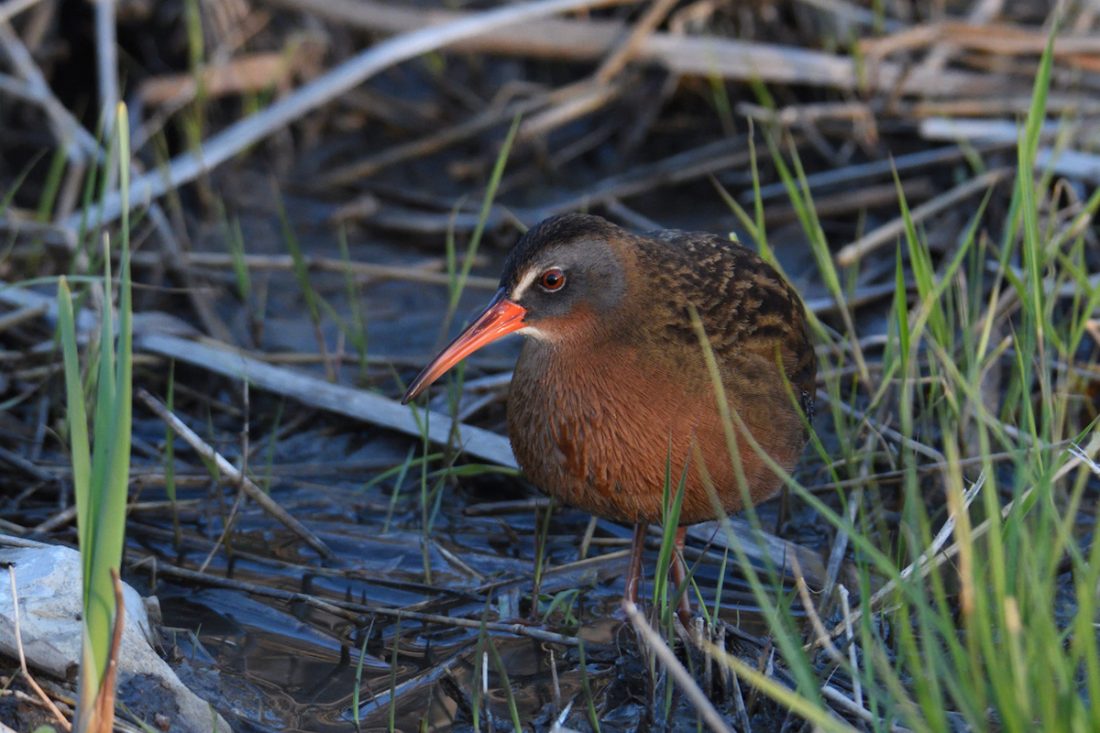
A Virginia rail forages in a wetland. Photo by Vern Wilkins, Indiana University, Bugwood.org.



A Virginia rail forages in a wetland. Photo by Vern Wilkins, Indiana University, Bugwood.org.
We arrive at the parking lot near dusk, pull on layers to keep the mosquitoes off despite the muggy air, secure headlamps and spotlights and head out into the wetland. This isn’t everyone’s idea of a fun evening, but the staff and technicians at Forbes Biological Station are excited to spend a few hours in the wetland this evening trying to capture migrating rails. We’ll walk slowly through the shallowly flooded wetland plants, and when a rail flies a short distance carefully run after it and secure it in a dip net.

We’re not always successful, these are secretive marsh birds after all, but once we have a sora or Virginia rail in hand, we take several measurements to assess its body condition, attach an aluminum band to its leg, collect a fecal sample, and, if the bird is large enough, give it a motus tag. This tag sits low on the bird’s back, supported by a harness that goes around its waist kind of like a fanny pack. The tag is small and low profile and weighs less than 3 percent of the bird’s weight which will allow the bird to fly, feed and migrate normally.
The tag allows us to track the bird’s movements locally along the Illinois River Valley and across the region. Each tag has a tiny radio transmitter in it, and it beeps a unique pattern. If that bird flies near one of our radio towers, we’ll record the beeps and know that bird was nearby. Sora and Virginia rails, while rarely seen by most people in Illinois, migrate through in large numbers in spring and fall, and frequently use the same wetlands as migratory waterfowl, but we know little about when they are here, and how they move around the landscape.

Over the past several years of tagging, Forbes staff have found that rails primarily use a small area (less than football field in size) during migratory stopovers along the Illinois River, and they use the same general area during the day and night. This is different than previous research done on waterfowl which shows many duck species moving between different habitats from day to night and using larger areas during migration. While rails migrate at night, a strategy adopted by many small birds likely to help prevent being eaten by larger aerial predators, and because of calmer more predictable winds at night, they aren’t active at night while on stopover. Our tagging effort has shown when rails stopover they are mostly active at dawn and dusk, though there is variation among individual birds.
Analysis is still ongoing for the migratory patterns of these birds, but we’ve had several interesting migratory movements already, including one bird that spent the summer somewhere in Canada, and last fall migrated through Kansas all the way to the Gulf of Mexico coast in Texas. Many mysteries remain around the migration of rails, including how many travel south of the United States during the winter, and how they make decisions about where to stop during migration.
Auriel M.V. Fournier is the Director Forbes Biological Station, Illinois Natural History Survey.
Submit a question for the author